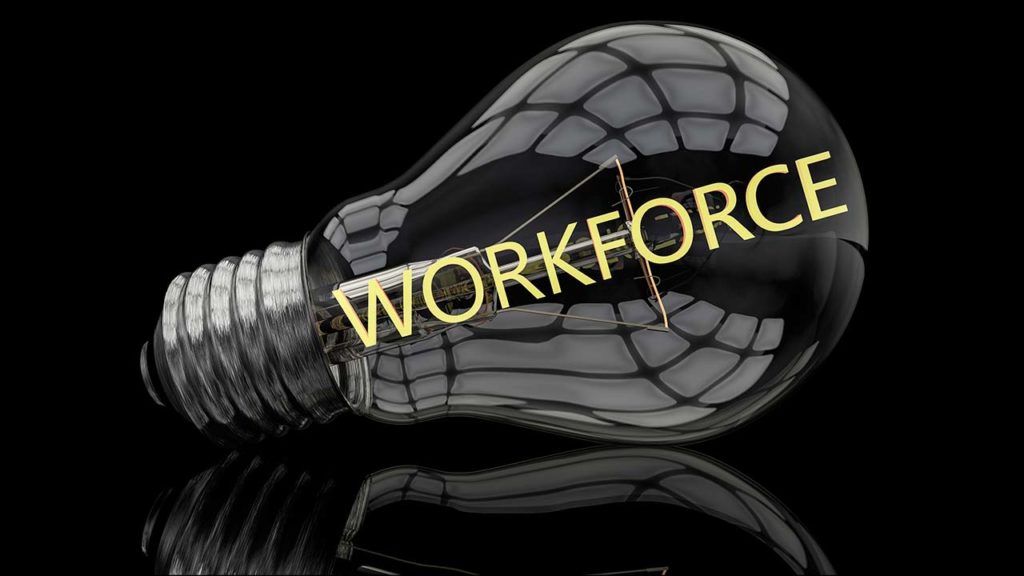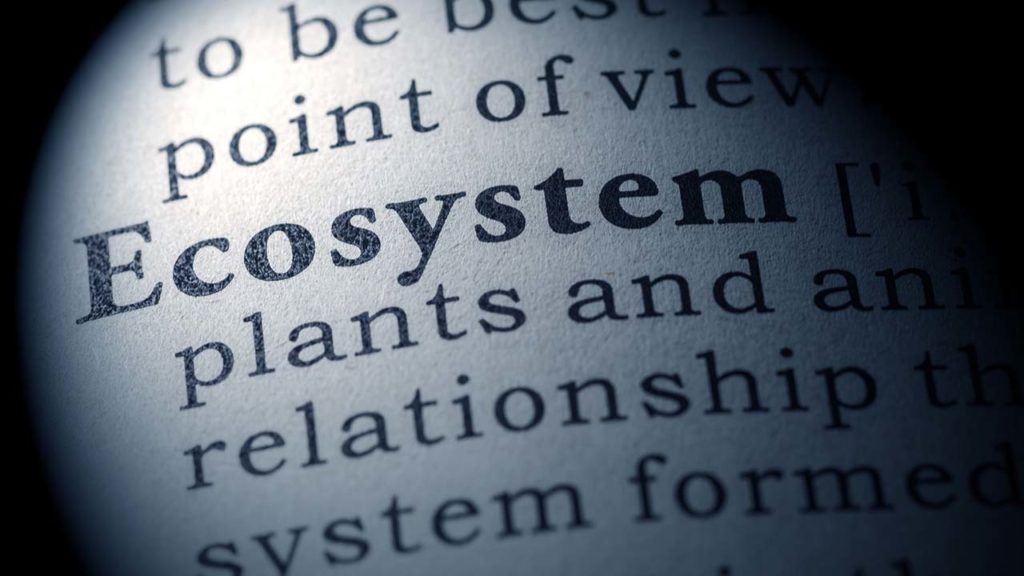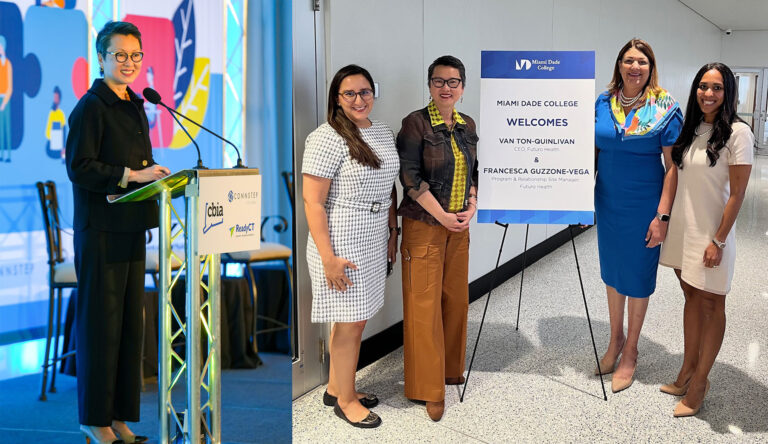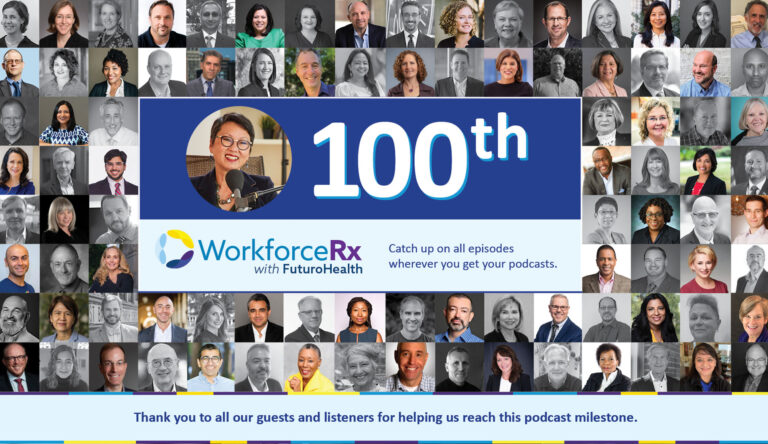COVID-19 might have sparked the labor crisis in America, but the systemic issues that underlie it predate the pandemic — like the cost of higher education, access to childcare, and systemic barriers to resources of all kinds.
Van Ton-Quinlivan is here to help change that. As CEO of Futuro Health, she leads a nonprofit with a mission to improve the health and wealth of communities by training healthcare workers for in-demand jobs in California.
But she can’t do it alone: “Education reform is not an individual sport,” says Van. “It is a team sport.”
As a veteran of the workforce development field, she knows collaboration is the only way we can correct the mismatch between open jobs and workers with the skills to fill them.
“Creating a talent pool from a talent puddle lies in finding an ecosystem of willing partners,” writes Van in her new book “WorkforceRx: Agile and Inclusive Strategies for Employers, Educators, and Workers in Unsettled Times.”
Futuro Health consultant Lynn Shaw says we used to use the term lifelong learning — but now, lifelong skill attainment is more accurate.
“I believe the workforce of the future, the way people learn and the jobs they have will be ever-changing,” she adds.
How can those of us in workforce development space meet these dynamic challenges? In a special episode of the WorkforceRx podcast, Van and her panel of guests share their playbooks, their growing pains and their wins.
Each of them begins with an icebreaker — suggesting a keyword they would use in order to find “WorkforceRx” on Amazon or Barnes and Noble. Then they talk about the insight, story or strategy that resonated with them the most, and why.
The Panelists
Rachel Unruh, Chief of External Affairs, National Skills Coalition
Amy Wallace, former Assistant Director for Workforce Innovation, California Workforce Development Board
Debra Jones, strategic design consultant; former Director, Workforce and Adult Education, California Community College Chancellor’s Office
Lynn Shaw, Consultant, Futuro Health; former Visiting Dean and Interim Director of Workforce and Economic Development, California Community College Chancellor’s Office
Flannery Hauck, Director, Service Employees International Union-United Healthcare Workers West
Kai Drekmeier, Chief Development Officer, Inside Track
Fred Freedman, Chief Executive Officer, Pima Medical Institute
Katie Brown (Nielson), Ph.D., Founder and Chief Education Officer, Voxy EnGen

Adapt to innovate, partner to maximize funding
Rachel Unruh, Chief of External Affairs with the National Skills Coalition, says “partnerships, adaptation, and innovation” are the keywords she would use to search for “WorkforceRx.”
She particularly resonated with Van’s story about creating a partnership between California community colleges and prominent businesses. “That involves bringing different folks to the table who represent different stakeholder groups and who had control over different funding streams,” she says.
Rachel emphasizes the importance of collaboration and the need to “braid funding streams in order to serve the greatest number of employers and workers.”
While Trade Adjustment Act Community College and Career Training (TAACCCT) grants helped community colleges and their partners build workforce ecosystems in response to the last big economic crisis — the Great Recession — there is still no dedicated funding “to sustain them and keep innovating through any crisis,” she notes.
“Given the disruption we saw with the pandemic, when workplaces saw 10 years of technological change overnight that required rapid re-skilling,” Rachel adds. “It’s going to be essential to have that capacity across the country as we respond in real time to economic disruptions.”

'Coalitions of the willing' create real change
Amy Wallace, the former Assistant Director for Workforce Innovation at the California Workforce Development Board, says her keyword search would be real change. She thinks “WorkforceRx” addresses how to “create the kinds of systems and structures and partnerships to ensure that change is actualized for workers and for businesses — and how to make that a long-term, sustainable proposition.”
Amy collaborated with Van “and many, many others” to create a regional initiative designed to address challenges at the intersection of the labor market, education, and economic development. At its heart were “coalitions of the willing,” says Amy — individuals and organizations “committed to moving the needle on job preparation, and our role really became just to get out of their way.”
Those partnerships drove change in the ways that were most meaningful to their communities, she adds.
“The lesson for me from this work was that there really is no one-size-fits-all solution to workforce development challenges, but having the right folks at the same table can be infinitely creative in getting the job done right.”

Strategy begins with aligned outcomes
As the Director of Workforce and Adult Education at the California Community College Chancellor’s Office, Debra Jones was what Van called her “lieutenant.”
That meant “many mornings and evenings and weekends and sometimes very late nights together,” Debra recalls. “Everything Van did was deliberate” — which is why strategy would be her search term.
“She created her ecosystem amongst a world of doubters and resisters,” says Debra.
How did Van do it? It began with a Friday morning breakfast with her two legislative policy insiders.
“That turned into every Friday morning and the breakfast crew grew,” says Debra. “That was the beginning of a strategically curated ecosystem of partners.”
Van and her breakfast club “developed a common language around the workforce,” Debra adds. “They defined California’s landscape by regions and sectors. They aligned grant schedules and outcomes. Most importantly, they became an echo chamber for each other, and that was powerful.”
The relationships forged over the breakfast table were integral to the passage of the Workforce Innovation and Opportunity Act (WIOA), signed by President Obama in 2015.
Van’s “family of colleagues … was a safe sounding board,” she says. “She could test out her ideas with the Friday group. Together they could strategize solutions that worked for each. It was a place where she could get real feedback. It wasn’t always positive, but it informed and shaped her next steps.”
The lesson can be summed up this way: “Curate your ecosystem,” Debra adds. “It will serve you well and strengthen your organization.”

As tech (and culture) evolves, the workforce should too
Lynn Shaw’s first experience with “workforce disruption through technology” was when she needed her refrigerator repaired.
“The repairman came, and the first thing he pulled out was a laptop. I was so shocked because he didn’t have a toolbox. That was when I realized: The workforce is really changing.”
That’s why workforce health is what Lynn would search for to find Van’s book.
Lynn, a consultant for Futuro Health and the former Interim Director of Workforce and Economic Development at the California Community College Chancellor’s Office, once apprenticed as an electrician. She says apprenticeship programs can “really change the way we train people.”
Lynn is a proponent of the “earn-as-you-learn approach: You start out with a job, learn on the job and learn in the classroom at the same time. It’s not like you go to school and then get a job — it’s all integrated.”
Lynn has also worked as a miner, a steelworker and a longshore worker, so she knows firsthand that the workforce has what she calls “occupational apartheid” — certain roles “are still women’s jobs or men’s jobs,” she explains. “I think if we can change the way people look at work to have no gender, that will create a different kind of talent pool — or talent ocean.”

Building an expansive ecosystem
Flannery Hauck, whose search term is ecosystem, says that “the power of people with a common interest and complementary assets can’t be understated.”
Whether we call it a team of rivals or a coalition of allies, an ecosystem of the willing can always agree on one thing: putting students and workers first, says Flannery, who serves as Director of Service Employees International Union-United Healthcare Workers West.
In Chapter 3, Van tells a story about Nathan, a Midwestern CEO who initially thought his company had “a really good tuition reimbursement program,” Flannery explains. “But he learned that employees need … things like childcare and second jobs, online programs that allow them to take advantage of the hours that they have to go to school, and affordability.”
The biggest problem was that the company covered the cost by reimbursement — not by disbursement. When Nathan changed that, program participants increased from 70 to more than 600.
“My takeaway as a union organizer is that the answer came from talking directly to the workers to understand the need,” Flannery says.

Agility + action = 'The speed of need'
If Inside Track Chief Development Officer Kai Drekmeier could choose one word to describe “WorkforceRx,” it would be agility — “but that wouldn’t be enough,” he says. “I would add action for effective workforce development.”
He thinks Futuro Health is “the embodiment of this concept of agility and working at the speed of need.”
Chapter 4 in particular resonated with Kai because it speaks to the work he does at educational coaching firm Inside Track — particularly with working adults, who “require flexibility and affordability,” he notes.
“There’s a passage that mentions that six in 10 people (in the U.S.) between 22 and 39 cited cost as the reason that they didn’t finish — or didn’t even pursue — any sort of post-secondary education … It’s really unbalanced and problematic and we’ve got to address that.”
Kai says we shouldn’t be surprised by the skills gap, given the difficulty of paying for college.
Employers are often hesitant to invest in employees who may leave. The model of “working at the same place for decades, and the mutual loyalty that goes with it, is sort of dead,” he adds. “So it requires new thinking. We are seeing employers step up and recognize that they’ve got to fund this.”

'Job placement drives curriculum'
“If I were looking up the book on Amazon, I might start with identifying tomorrow’s workforce,” says Fred Freedman, Chief Executive Officer of Pima Medical Institute. But he thinks we don’t just need to identify likely candidates — we need to “groom them so that they understand exactly what role they play.”
In today’s world, a degree (or even what anyone knows) isn’t nearly as important as what someone can do. So career-focused education, particularly technical skills, are what’s necessary to “move at the speed of business,” as Van puts it.
As a private career college, Pima Medical is used to that concept — “because we are literally preparing today’s workforce for tomorrow,” Fred says. “One adage we use is job placement drives curriculum. We prepare people based on employers’ needs.”
Meeting the demands of business lightning-quick isn’t easy for educational institutions, he adds. The ship of higher ed takes a long time to turn, but industries move like speedboats.
“So whether it’s public-private partnerships or private collaborations, none of us can go it alone. In order to satisfy workforce needs, we have to be flexible and scalable … or we simply won’t be able to provide a satisfying solution to the employment needs of today’s workforce.”

Resources themselves just aren't enough
Voxy EnGen’s Founder and Chief Education Officer Katie Brown found “WorkforceRx” full of “operating instructions for how to solve specific workforce problems.”
Katie’s mission is to help historically under-resourced populations get access to the kinds of skills and training they need for jobs with economic mobility. Those populations are often overlooked, she explains, “because they don’t have the support to take advantage of the resources that are offered.”
Uncovering hidden talent is the phrase she’d use to find Van’s book. That is particularly resonant for Katie, who knows that much of the workforce is “facing systemic barriers to access to digital literacy or to language.”
If we can’t support the people who face those challenges, “we’re never going to be able to develop the talent that we need to have for the future,” she adds. That’s why she wholeheartedly agrees with Van’s argument in “WorkforceRx” that “it’s not enough just to provide resources to workers. We need to make sure those resources actually get used.”
This article is based on a special episode of the Workforce Rx with Futuro Health podcast. Episodes feature leaders and innovators sharing insights into the future of work, future of care, future of higher education, and alternative education-to-work models. Be sure to subscribe via Apple, Spotify or wherever you get your podcasts.



